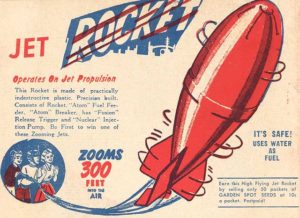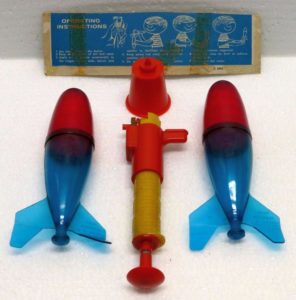
I certainly didn’t hurt for toys when I was a kid. However, I didn’t have EVERY toy.
Witness the Texaco Fire Truck. Another cool toy that sadly never made it into my toybox was the water rocket.
I saw hundreds of ads for water rockets in various comic book ads.
One day at junior high school, for a science demonstration, I finally got to witness a water rocket in action.
Pretty cool stuff! So cool, that nowadays there is a passionate online following of homegrown water rockets. Read on.
The water rocket was allegedly created in 1930 by future professor Jean LeBot in Rennes, France. While still a student at school, he experimented with a champagne bottle (designed to hold high pressure) filled partially with water and pressurized by compressed air from a bicycle pump fed through a cork with an inner tube valve at its center. The rocket was launched from an inclined plank forming a ramp.
It flew well, but the bottle would smash on impact.

At some point after that (the details are very sketchy), toy manufacturers began marketing water rockets made from high-impact plastic. The rocket would sit on a plastic hand pump and launch with a trigger pull.
I found photos of some rockets that were manufactured in Germany in the early 50’s and that looked just like the V-2 models that rained down on Great Britain.
Later models included curved fins that would put a spin on the rocket, causing it to fly higher and straighter.
Once you pumped the launcher enough times to achieve optimal pressure, you pulled the trigger and were rewarded by a rocket shooting skyward, accompanied by a satisfying hissing sound and a jet trail of water and water vapor.
Then, the device would plummet to earth (the nicer models included a rubber padded nose cone to absorb the impact).
The comic book ads we grew up with are long gone, but water rockets continue to exist today, looking very much like we remember them.
However, there is a passionate following of home-built water rockets out there on the web. Most of the rockets are made out of plastic two-liter soda bottles. The lightweight cylinders can withstand high pressure, and are thus ideal for aeronautical flight. Not only that, they don’t shatter like glass champagne bottles when they land.
I remember having one of these for Christmas in 1958. It did indeed go to a seemingly 300 ft, had as you say a red rubber nose cone and was red, clear and blue at the base and fins. It was launched by a grey bicycle pump with a metal catch. The second day out, in thick snow, I lost it when it landed in someones garden undergrowth a hundred yards away after the wind took it off course. I thought it was made of polypropylene as it had a slighty waxy feel to its surface i remember. It was quit heavy too. I kept the pump for years hoping to get another rocket to give to my kids. They did bring them back but much smaller and only went a hundred foot high.
I had one with a red transparent top and white bottom, that shot off a red and white launcher. It was great fun and would really fly. Naturally after a few launches up we began shooting them at each other – not very accurate but lots of fun. But, the biggest thing I remember was the smell of the plastic – is that weird or what?